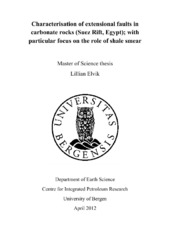Characterisation of extensional faults in carbonate rocks (Suez Rift, Egypt); with particular focus on the role of shale smear
Master thesis
Permanent lenke
https://hdl.handle.net/1956/6086Utgivelsesdato
2012-04-27Metadata
Vis full innførselSamlinger
- Department of Earth Science [1034]
Sammendrag
The distribution, composition and flow-properties of fault core and shale smear along faults in carbonate reservoirs is less well understood compared to faults in siliciclastic rocks. This study uses field data to characterize and quantify fault zone properties that are critical for understanding structural heterogeneity in carbonate reservoirs. The study focus on; (1) variability and co-dependence of displacement, shale smear, fault- thickness, -composition and -geometry; (2) the effect of shale smearing on fault (core and inner damage zone) deformation; and (3) implications for fluid flow in fault zones in carbonate rocks. The study area is located on the eastern flank of the Oligocene-Miocene Suez Rift and features large extensional fault arrays affecting fine grained carbonates of Upper Cretaceous to Eocene age. This study is based on structural data from two of these faults (3-6 km length; 30 to 550 m throw). The results show variations in the fault core geometry and composition along the faults. Compositionally, the fault cores are comprised of carbonate breccias, shale smear, secondary calcite and host rock lenses. There is also a significant variation in the thickness of shale smear where this is present (up to 2 m thickness recorded). Investigation of the variability of the said fault parameters indicates that the properties of fault core and inner damage zone are affected by the presence or absence of shale smear. Shale smear introduces a weak mechanical layer in the fault, acting as a "lubricant" or cushion" during slip. This appears to control the structural style and geometry of the fault core, and have also been observed to affect the inner damage zone in terms of enhanced fracture intensities, where shale smear is absent. In turn, both shale smear, in its own right as well as fault core properties, control the effect of any fault on fluid flow. Thus, the present study contributes new knowledge to fault seal analysis in subsurface carbonate reservoirs.
